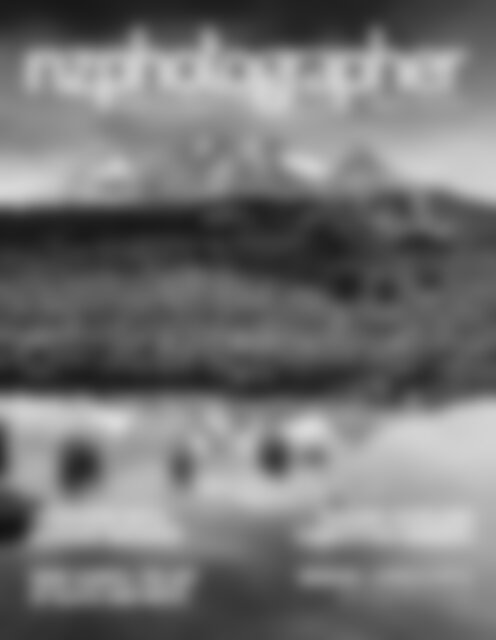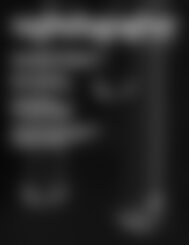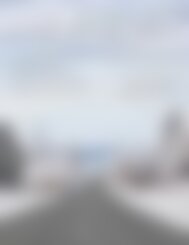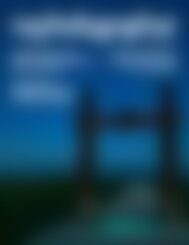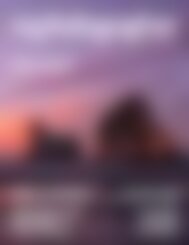NZPhotographer Issue 22, August 2019
As of December 2022, NZPhotographer magazine is only available when you purchase an annual or monthly subscription via the NZP website. Find out more: www.nzphotographer.nz
As of December 2022, NZPhotographer magazine is only available when you purchase an annual or monthly subscription via the NZP website. Find out more: www.nzphotographer.nz
Create successful ePaper yourself
Turn your PDF publications into a flip-book with our unique Google optimized e-Paper software.
Brought to you by<br />
ISSUE <strong>22</strong>, <strong>August</strong> <strong>2019</strong><br />
INTERVIEW WITH<br />
RICHARD BROOKER<br />
MIND GAMES: THE ART<br />
OF BLACK AND WHITE<br />
IMAGINE AUCKLAND<br />
COMPETITION WINNERS<br />
MINIMAL LANDSCAPES<br />
BY RICHARD YOUNG<br />
<strong>August</strong> <strong>2019</strong><br />
1
WELCOME TO ISSUE <strong>22</strong> OF<br />
NZ PHOTOGRAPHER MAGAZINE<br />
HELLO EVERYONE,<br />
I can't resist putting a spin on an<br />
old joke and asking you 'what's<br />
black, white, and read all over?'<br />
<strong>Issue</strong> <strong>22</strong> of NZ Photographer of<br />
course; our monochrome focused<br />
issue!<br />
Start to see our colourful world in<br />
a different way as you peruse the<br />
following pages, and get inspired<br />
to go out and capture your own<br />
black and white masterpieces.<br />
Articles from Ana and, guest<br />
author, Peter Kurdulija serve up<br />
a double dose of thought and<br />
inspiration as to why you should<br />
shoot in monochrome whilst<br />
Richard Young's article shows<br />
us that we don't have to turn to<br />
black and white to make a photo<br />
minimalistic.<br />
If the Winter Blues have got you<br />
down and you're in need of<br />
new photo location inspiration, see if our Behind The Shot feature with Jason<br />
Blair tempts you out into the snow. No? How about taking to the railway as<br />
Brendon has been doing? Alternatively, our interview with Richard Brooker<br />
might be the inspiration you need whether you find yourself wanting to go find<br />
and photograph abandoned buildings or realise that a complete change of<br />
genre is what you need to shake up your photography for the better.<br />
As well as announcing the winners of the Imagine Auckland competition,<br />
we're pleased to bring you the first in a new series to promote<br />
#WomenInPhotography – Each month we'll be getting to know one of Lesley<br />
Whyte's female photographers as we discover how her photography journey<br />
started and where she hopes it will lead.<br />
Emily Goodwin<br />
Editor NZ Photographer<br />
General Info:<br />
<strong>NZPhotographer</strong> <strong>Issue</strong> <strong>22</strong><br />
<strong>August</strong> <strong>2019</strong><br />
Cover Photo<br />
"Ruapehu"<br />
by Richard Brooker<br />
Publisher:<br />
Excio Group<br />
Website:<br />
www.excio.io/nzphotographer<br />
Group Director:<br />
Ana Lyubich<br />
Editor:<br />
Emily Goodwin<br />
Graphic Design:<br />
Maksim Topyrkin<br />
Advertising Enquiries:<br />
Email hello@excio.io<br />
2 <strong>NZPhotographer</strong>
REGULAR CONTRIBUTORS<br />
Brendon Gilchrist<br />
Brendon is the man<br />
behind ESB Photography.<br />
He is an avid tramper<br />
who treks from sea to<br />
mountain, and back<br />
again, capturing the<br />
uniqueness of New<br />
Zealand’s unforgiving<br />
landscape.<br />
Ana Lyubich<br />
Co-founder of Excio, Ana's<br />
photography journey<br />
started many years ago<br />
with one of the first Kodak<br />
film cameras. She loves<br />
exploring the unseen<br />
macro world and capturing<br />
genuine people's emotions.<br />
Richard Young<br />
Richard is an awardwinning<br />
landscape and<br />
wildlife photographer who<br />
teaches photography<br />
workshops and runs<br />
photography tours. He<br />
is the founder of New<br />
Zealand Photography<br />
Workshops.<br />
nzphotographer nzp_magazine nzp@excio.io<br />
© <strong>2019</strong> <strong>NZPhotographer</strong> Magazine<br />
All rights reserved. Reproduction of any material appearing in this magazine in<br />
any form is forbidden without prior consent of the publisher.<br />
Disclaimer:<br />
Opinions of contributing authors do not necessarily reflect the<br />
opinion of the magazine.<br />
<strong>August</strong> <strong>2019</strong><br />
3
CONTENTS<br />
6<br />
HOW MONOCHROME CAN<br />
CONVEY YOUR DISTINCT<br />
PERCEPTION OF THE WORLD<br />
BY PETER KURDULIJA<br />
BEHIND THE SHOT<br />
WITH JASON BLAIR<br />
6<br />
10<br />
14<br />
24<br />
39<br />
BEHIND THE SHOT<br />
with Jason Blair<br />
CHUGGING ALONG THE RAILWAY<br />
by Brendon Gilchrist<br />
INTERVIEW WITH RICHARD BROOKER<br />
HOW MONOCHROME CAN CONVEY YOUR DISTINCT<br />
PERCEPTION OF THE WORLD<br />
By Peter Kurdulija<br />
IMAGINE AUCKLAND COMPETITION<br />
WINNERS AND BEST ENTRIES<br />
54 #WOMENINPHOTOGRAPHY<br />
GETTING TO KNOW RAEWYN SMITH<br />
62<br />
66<br />
IMPROVING YOUR PHOTOGRAPHY<br />
PHOTO REVIEW SESSION<br />
MINIMAL LANDSCAPES<br />
by Richard Young<br />
24<br />
INTERVIEW<br />
WITH RICHARD BROOKER<br />
70 BEST READERS SUBMISSIONS THIS MONTH 14<br />
#WOMENINPHOTOGRAPHY<br />
GETTING TO KNOW RAEWYN SMITH<br />
54
Deliver<br />
a larger<br />
impact.<br />
BONUS<br />
Epson Signature<br />
Worthy Sample<br />
Pack**<br />
EPSON PHOTO RANGE – FOR PHOTOGRAPHERS WHO WANT MORE<br />
· Unparalleled print quality: Print at resolutions up to<br />
5760x1440 dpi using advanced Epson all-pigment ink<br />
· Outstanding productivity: Print at high speed with<br />
cost-effective high-capacity ink cartridges up to 200 ml<br />
· Exceptional media support: Print on the widest range of<br />
fine art media including roll based stocks, and thick board*<br />
· Superior control: Print with maximum precision via an advanced<br />
driver, special Black & White Mode, and an optional SpectroProofer*<br />
· Simpler operation: Epson Print Layout Software for rapid production<br />
of a vwide range of outputs for various display requirements<br />
· Lower maintenance: Stable permanent print heads covered by a<br />
comprehensive warranty with optional on-site service extendable up to 5 years<br />
SC-P600 A3+<br />
SC-P5070 A2+<br />
SC-P800 A2+<br />
Learn more, visit www.epson.co.nz<br />
*SureColor P5070 only<br />
**Valid with purchase of SC-P600, SC-P800 from Epson or selected resellers.
Behind The Shot<br />
with Jason Blair<br />
HOW DID YOUR PHOTOGRAPHY JOURNEY<br />
START?<br />
I had a keen interest in photography from a young<br />
age. After finding the academic environment of<br />
university wasn’t a good fit for me, I decided to<br />
turn my interest in photography into a possible<br />
career option and enrolled in a Diploma Course in<br />
Photography at UCOL.<br />
Fast forward and I started my company Katabatic<br />
Creative, initially as a way for me to formalise my<br />
side-hustle while I worked a variety of other jobs.<br />
Subsequently the business has grown to incorporate<br />
my commercial and editorial photography business as<br />
well as a graphic design and print studio in Hokitika on<br />
the West Coast.<br />
6 <strong>NZPhotographer</strong>
Creating a company was the easiest way for me to<br />
compartmentalise and separate business activities<br />
and expenses from personal, which suits the way my<br />
brain works. I’m glad I did it early on as it forced me<br />
to be more serious about the endeavour and I think it<br />
would have been challenging to untangle and set up<br />
further down the track.<br />
BEHIND THE SHOT IS PROUDLY<br />
SUPPORTED BY<br />
<strong>August</strong> <strong>2019</strong><br />
7
WHAT'S YOUR BIGGEST PHOTOGRAPHY<br />
ACHIEVEMENT?<br />
It’s hard to isolate a single achievement, but<br />
awards wise, I’m very proud of taking home a<br />
Gold in the Commercial category at the NZIPP Iris<br />
Awards in 2013, and subsequently becoming a<br />
Fellow of the Institute (now known as a Master with<br />
two bars).<br />
TELL US ABOUT YOUR POWDER HOUNDS SHOT…<br />
I photographed this during an introduction to ski<br />
touring course run by the West Coast Alpine Club.<br />
I was volunteering to help the instructor, and also<br />
photographing for the club’s usage and my own<br />
interest/portfolio. This combination of being active in<br />
the outdoors, volunteering, and photographing is a<br />
significant thread of my photography outside of my<br />
commercial work.<br />
I enjoy photographing the activities that I love to<br />
participate in, and it’s nice to work without the<br />
pressure and constraint of a commercial brief<br />
(although I do really enjoy that also).<br />
This shot came about while the course participants<br />
were having some “free experimentation” time to get<br />
accustomed to their equipment in a small bowl below<br />
Cheeseman Skifield.<br />
The subject is Troy, who was actually another<br />
volunteer helping out. I spotted him lower down the<br />
hill with Max and Kingston, his dogs, and noticed<br />
that I was close to the edge of the shadow being<br />
cast by the ridge. I moved over to the boundary<br />
of the shadow to place the sun close to the rim of<br />
the ridge and asked Troy to ascend so that he’d<br />
end up between me and the sun. I exposed for<br />
the sky, focused on the ridge top, and captured<br />
a series of frames as he approached and passed<br />
the sun, hoping for a dynamic and strong silhouette<br />
composition.<br />
As it happened, the position of the dogs was the<br />
deciding factor in which frame was the most<br />
appealing, so I selected this one rather than one<br />
where he was directly in front of the sun which I’d<br />
imagined would work best.<br />
DID YOU PLAN TO SHOOT THIS IN B&W OR<br />
WAS IT CONVERTED LATER FROM COLOUR?<br />
Silhouettes always lend themselves to B&W<br />
conversion, and I tend to operate with my camera<br />
monitor displaying monochrome all the time as I find it<br />
helps me focus on composition more so this shot was<br />
always likely to end up a black and white image.<br />
That said, it was really when I tried it with a few<br />
different conversions and saw the interesting cloud<br />
really pop with a “red filter” profile that I was really sure<br />
that this was the best way to present the photograph.<br />
WHAT DO YOU LIKE ABOUT THIS SHOT, IS THERE<br />
ANYTHING YOU WOULD CHANGE?<br />
I really enjoy a simple, graphic photograph and this<br />
one is particularly satisfying because I pre-visualised<br />
something and was able to construct something very<br />
close to, and perhaps even better than, what I had in<br />
my head.<br />
As I said above, I think the position of the dogs is a key<br />
element here so if I could improve one thing it would<br />
be having the second dog separated from Troy’s<br />
outline and in a more dynamic pose like the first dog<br />
is, and perhaps both dogs right on the horizon of the<br />
ridge so that their legs are visible.<br />
ANY TIPS FOR OUR READERS ON MAKING<br />
PHOTOGRAPHY A CAREER?<br />
Photography is a wonderful art and can make a very<br />
rewarding career, but it isn’t an easy way to make a<br />
living, especially starting out. I would say value your<br />
work, persevere, and seek mentorship.<br />
Black and white image making is wonderful and<br />
rewarding, but it almost certainly won’t pay the bills!<br />
But that doesn’t mean you shouldn’t do it. Shoot with<br />
your camera displaying black and white previews<br />
and it will improve your overall photography, as well<br />
as your black and white images, of course.<br />
HOW DID YOU DISCOVER EXCIO?<br />
I won an Excio subscription through the Federated<br />
Mountain Clubs photography competition, I think it<br />
was actually with this image! To be honest though, I’m<br />
still working out exactly what Excio is and how to drive<br />
the platform but I find the concept quite interesting<br />
and look forward to learning and experimenting<br />
more.<br />
WHAT ARE YOUR PLANS FOR THE FUTURE?<br />
I’m currently developing a new personal project<br />
involving photography and video, outdoor recreation,<br />
and mental health. I’m seeking funding to get it off<br />
the ground at present and assembling a team to help<br />
produce it. So hopefully I’ll be very busy with that in<br />
the near future!<br />
WHERE CAN WE FIND YOU ONLINE?<br />
www.instagram.com/jaseblair<br />
www.facebook.com/KatabaticCreative<br />
www.katabatic.co.nz<br />
albums.excio.io/profile/Jase
FRESH SHOOTS<br />
PHOTO COMPETITION<br />
We’re inviting photographers to highlight all the wonderful things that make the Wellington<br />
Botanic Garden much more than a garden, while encouraging photographers to focus on<br />
the garden season by season.<br />
For prizes and full Terms & Conditions see: www.excio.io/freshshoots<br />
The last season of the competition is now open:<br />
Winter<br />
<strong>22</strong> June - 20 September <strong>2019</strong><br />
CATEGORIES<br />
NATURE<br />
PEOPLE &<br />
EVENTS<br />
CREATIVE<br />
PARTNERS<br />
<strong>August</strong> <strong>2019</strong><br />
9
Chugging Along The Railway<br />
by Brendon Gilchrist<br />
F5, 1/500s, ISO160, 80mm<br />
10 <strong>NZPhotographer</strong>
<strong>August</strong> <strong>2019</strong><br />
11
F5.6, 1/1000s ISO64, 24mm<br />
If you are a train fanatic, this journey will be one<br />
you want to put on your list. Through the mountains<br />
from Christchurch to Greymouth, or vice versa, this<br />
is a trip that will take you through so many different<br />
landscapes that you’ll be wondering why you didn’t<br />
do it sooner.<br />
It’s not just for old retired people, all ages should get<br />
onboard – Pack your suitcases, stay a few nights and<br />
then return on the same train you came on. You could<br />
rent a car and explore some of the west coast gems<br />
like Punakaiki, head on down to glacier country, or just<br />
hang around Greymouth where there is plenty to see<br />
and do.<br />
Still need enticing? Let me take you on my train<br />
journey…<br />
The day starts early as the train leaves at 8.15am from<br />
Christchurch Central Train Station. The carriages are<br />
comfy, warm on this cool winters morning and the<br />
commentary oh so funny making the staff top-notch<br />
and easy to talk to if and when needed.<br />
Upon leaving the station there’s a short section<br />
through the urban jungle along the straight tracks<br />
but the views soon improve as the mountains slowly<br />
get bigger and bigger the further out we go – The<br />
Canterbury plains are one of the biggest plains in<br />
New Zealand and are a magnet as you can see the<br />
Southern Alps.<br />
Cars stop for us when the bells clang at the railway<br />
crossings as we have the right of way to pass through<br />
on our journey to the other side of the island. There are<br />
a few stops on the way out to the mountains to pick<br />
up more passengers, these being Rolleston, Darfield<br />
and then Springfield but you only have a couple of<br />
minutes at each location with no time to exit the train,<br />
each stop getting you one step closer to the highlight<br />
of the trip, a train ride through the mountainside.<br />
At Springfield, the train leaves the main highway<br />
behind, turning off to follow the Waimakariri River and<br />
travelling along the gorge. Somehow, looking into the<br />
river from a train window makes it look more beautiful<br />
and surreal. The crystal clear water from the glacier’s<br />
that feed the river and the way that water has shaped<br />
this landscape over thousands of years is a sight to<br />
behold. With perfect blue sky and no weather systems<br />
to worry about I thought how can this get better?<br />
It wasn’t long untill we entered an area that is well<br />
known for its very cold temperatures, and there was<br />
no disappointment as there was a hoar frost, or what<br />
I call a white winter landscape. It looked so pure with<br />
many small frozen ponds and as we entered and<br />
exited short tunnels this hoar frost just kept going.<br />
I was outside in the viewing carriage so it was cold<br />
and with the train moving at a good speed I found it<br />
hard to get good photos. I wish the train could have<br />
stopped but it was not to be. I worked with what<br />
12 <strong>NZPhotographer</strong>
I had, one carriage with lots of other people with the<br />
same objective of capturing this Winter wonderland<br />
that just went on and on – I knew this area had hoar<br />
frost but I had no idea the area it covered was so<br />
large so it was the biggest and best surprise of the<br />
day. The best image I got was when we went over<br />
the Broken River bridge, a quick couple of snaps and<br />
I managed to get something stunning.<br />
Once at Arthurs Pass, we got the first opportunity to<br />
exit the train and stretch our legs on the platform<br />
before the darkest part of the trip; the Otira Tunnel.<br />
This tunnel starts at Arthurs Pass and exits the mountain<br />
8.5km later (roughly a 20minute journey) and has a<br />
gradient of 1 in 33 meaning that for every 33 meters<br />
you travel you either gain or lose 1 meter in height.<br />
Construction on the bridge started in 1907 and<br />
finished 11 years later in 1918. At that time it was<br />
the 7th longest tunnel in the world, an incredible<br />
achievement in that day and age.<br />
Upon exiting the tunnel on the West Coast side<br />
we entered into a lush green rainforest beside the<br />
Rolleston River. It left me marveling at how it’s possible<br />
such a stunning location with a scenic railway right<br />
beside it can exist.<br />
Heading towards the old railway town of Otira, the<br />
river changes from the Rolleston to the Otira to the<br />
Taramakau before we take a right-hand turn and<br />
head towards Moana, a small township on the shores<br />
of Lake Brunner where some passengers disembark<br />
and others join us.<br />
Lake Brunner is small, you get a view of it before you<br />
get to Moana and a quick view as you leave, but it<br />
was enough to whet my appetite, a place I would like<br />
to go back to and explore with my sea kayak on a<br />
calm day as the reflections looked like glass from the<br />
train.<br />
By now we’re almost 6 hours into our journey and<br />
approaching our final destination having passed<br />
through many different photo-worthy landscapes.<br />
At Stillwater, a small village on the edge of the Grey<br />
River, the view is spectacular from the railway track;<br />
limestone shaped walls with a deep river running<br />
through it that draws in the white water kayakers and<br />
other visitors who want to see the site of the Brunner<br />
Mine, the place where 65 people were killed in 1896.<br />
Once into Greymouth, our final destination, I had a<br />
1-hour break before I was back on the train for the<br />
reverse journey. To go there and back in 1 day it’s<br />
a 13 hour journey so I do recommend staying a few<br />
nights to split the journey up a bit and give yourself<br />
more time to see what Greymouth and the west coast<br />
has to offer.<br />
3 TIPS FOR PHOTOGRAPHING ON A TRAIN<br />
JOURNEY.<br />
• Have your shutter set to burst mode so that you<br />
don't miss the shot.<br />
• Have settings as if you were taking sports images<br />
so a very high shutter speed to take into account<br />
that the train is travelling at a speed.<br />
• Since your shutter speed is so high you need to<br />
compensate that with your aperture. F4 to F5 will<br />
be enough to have plenty in focus without it being<br />
too dark.<br />
F7.1, 1/800s, ISO64<br />
<strong>August</strong> <strong>2019</strong><br />
13
Interview with<br />
Richard Brooker<br />
PAREWANUI<br />
F1.4, 1/100s, ISO800<br />
14 <strong>NZPhotographer</strong>
<strong>August</strong> <strong>2019</strong><br />
15
• Canon 5DMk4<br />
• EF 16–35 f/2.8<br />
• EF 50 f/1.4<br />
• EF 85 f/1.8<br />
• EF 100 f/2.8 Macro<br />
• EF 70–200 f/2.8<br />
• EF 2x Converter<br />
• Nisi Filters<br />
• RRS panorama head<br />
Over and above this, I have 2 Godox AD200 studio<br />
lights (the wee ones) while I learn studio portraiture.<br />
WOULD YOU SAY YOU HAVE A CERTAIN<br />
PHOTOGRAPHIC STYLE?<br />
No, I do not believe I have a certain style. I can<br />
never decide which ‘look’ I prefer and so, from<br />
a single shoot, I often produce images that look<br />
totally different; each edit suiting the photograph<br />
but no two photographs looking the same. I look<br />
at other peoples’ work and can see the similarities,<br />
or their signature, but I am still looking for that<br />
something that is uniquely ‘me’.<br />
RICHARD, TELL US WHO YOU ARE AND WHAT<br />
YOU DO...<br />
I work as an Oracle database administrator for<br />
enterpriseIT, a Wellington based IT company with<br />
large ambitions. Outside of work, I am a father<br />
to four boys, ages 9 to 16… who now run for their<br />
lives whenever I bring my camera out. Work keeps<br />
me pretty busy during the week, but when the<br />
weekend rolls around, I like to go and photograph<br />
whatever I can.<br />
SO HOW AND WHEN DID YOUR<br />
PHOTOGRAPHY VENTURE BEGIN?<br />
Photography for me started in 2012 when Instagram<br />
was released on the android platform. My first ever<br />
Instagram photo was of a sock, hanging on the<br />
corner of a washing line. In typical Wellington style,<br />
the sock had blown off by the time I had my phone<br />
ready to take the picture.<br />
Borrowing a DSLR from a friend for a roadie<br />
way back in 2013, I developed a penchant for<br />
photographing abandoned buildings. Purchasing<br />
TELL US ABOUT YOUR GEAR…<br />
I have been quite lucky with the camera gear<br />
that I have had over the years. Moving from a<br />
cellphone, my father bought me my first DSLR, a<br />
Canon 60D in 2014. I had two kit lenses with this<br />
camera, an 18–55 and a 55–250mm. Riiiight up<br />
until water entered the camera body while I was<br />
shooting my son on the high ropes at his school<br />
camp (he did very well by the way!).<br />
Insurance came to the party at this point with<br />
a replacement Canon 70D which I augmented<br />
with an EF-S10–<strong>22</strong>mm wide angle lens. This combo<br />
lasted three years and thousands of k’s until my<br />
grandfather passed away. My grandfather was<br />
an exceptional man and in his infinite wisdom he<br />
left some money to each of his grandchildren,<br />
enough to begin quite a nice kit so this is what I am<br />
currently shooting with:<br />
16 <strong>NZPhotographer</strong>
PATEA MEAT WORKS<br />
F4.5, 1/20s, ISO640<br />
my own DSLR in 2014 caused my interest in<br />
urban exploration to really take off (I have been<br />
frogmarched off premises more than once for<br />
being where I shouldn’t). There are a surprising<br />
amount of derelict buildings around NZ if you are<br />
prepared to drive a ways.<br />
Since then I have moved through landscape<br />
photography, attempted macro photography, and<br />
am now heading down the road of wanting to be<br />
a people photographer. People express so many<br />
emotions in so many ways; I would like to discover<br />
how to capture that in a way that makes people<br />
wonder what was going on when the photo was<br />
taken. My macro lens makes a very fine portraiture<br />
lens and I’m always looking for people who do not<br />
mind having their photo taken… Hint, hint!<br />
TELL US MORE ABOUT THE ABANDONED<br />
BUILDINGS, WHAT FASCINATED YOU?<br />
I liked to walk where others had been but no<br />
longer frequented. I liked the thrill of being caught.<br />
I do not tend to do this often anymore; I am a<br />
little old now to be vaulting over barbed wire<br />
fences without leaving patches of skin behind but<br />
I have dreams of going to places like Chernobyl,<br />
Detroit, Gary Indiana… places where industry has<br />
subsided leaving behind mechanical monstrosities,<br />
monstrosities waiting to be explored.<br />
The great thing about abandoned places is<br />
that they are generally hidden in plain sight. In<br />
Wellington, there are several places which are<br />
quietly rotting, still in the public eye. Head out<br />
into the country and the number of abandoned<br />
buildings goes up dramatically. All up and down<br />
the North Island there are abandoned structures<br />
waiting. I have not made it down to the South<br />
Island yet, but I’m sure there are plenty to find<br />
down there also.<br />
YOU HINTED AT BEING FROGMARCHED<br />
OFF OF CERTAIN PROPERTIES, ANY OTHER<br />
NARROW ESCAPES YOU CAN TELL US<br />
ABOUT?<br />
North of Wellington, there is an abandoned<br />
Catholic girl’s school, visible from the state<br />
highway. Exploring those buildings taught me a<br />
valuable lesson: make sure you always have a<br />
way out. I was photographing three side by side<br />
toilet stalls and was moving slowly backwards to<br />
see if I could fit them in frame. The door (sans door<br />
handle) closed and I heard the latch ‘click’. Well…<br />
stuck in a toilet, no door handle, I had to ‘squeeze’<br />
out of a smaller-than-ideal hole in the wall to get<br />
out and managed to almost remove my finger in<br />
the process. A quick trip to the hospital, a stern<br />
telling off by the doctor, and I was back planning<br />
new targets within the week!<br />
<strong>August</strong> <strong>2019</strong><br />
17
TONGARIRO CROSSING<br />
F2.8, 1/1000s, ISO50<br />
YOU SAID YOU’VE ‘MOVED THROUGH<br />
LANDSCAPE PHOTOGRAPHY’ – WHAT MADE<br />
YOU MOVE ON?<br />
I spent the longest time shooting landscape<br />
photography and there have been some good<br />
times. I enjoyed capturing long exposures of<br />
moving water (as you’ll remember from issue 5)<br />
from beaches to rivers and waterfalls, there is plenty<br />
of moving water with interesting rock formations<br />
around New Zealand and I have photos from all<br />
over the North Island, Tongariro National Park being<br />
one of my favourite places to shoot.<br />
However, when I was asked to shoot headshots<br />
for The Fashion Creative, I had my first glimpse of<br />
what it’s like to shoot people, people who WANT<br />
their photo taken. The quality of photo’s produced<br />
by TFC is very high; it’s a great place to learn and<br />
great people to learn from. At that point, I decided<br />
that landscapes look better with people in them<br />
and landscapes with people in them are called…<br />
portraits;)<br />
WHAT HAVE BEEN YOUR BIGGEST LEARNING<br />
CURVES IN PHOTOGRAPHY?<br />
Technically there were a couple of eureka<br />
moments for me early on after changing from a<br />
cell phone to a DSLR (realising that the f-stop scale<br />
for aperture went down where the others go up<br />
and learning that the peg at the bottom of the<br />
viewfinder was a light meter)!<br />
Photographically, I haven’t stopped learning<br />
and I doubt I ever will. Each type of photography<br />
I’ve tried has had its challenges; for abandoned<br />
buildings it was finding places, finding entry to those<br />
places, trying to get a usable photo from what was<br />
usually a pretty dark place (no power = no lights)<br />
while trying not to get caught and evicted.<br />
For landscapes my problem was trying to capture<br />
the whole dynamic range, maintaining both the<br />
highlights and the shadows – Especially when the<br />
exposure is measured in minutes. This was probably<br />
the most expensive learning curve for me as it<br />
added several expensive filters and a panorama<br />
head to my kit.<br />
As for portraiture, I now own a couple of small<br />
studio lights and am learning how to use them.<br />
Trying to shape the light to get the look that<br />
I want… let’s say I’ve a ways to go yet!<br />
I spend time trolling the internet learning about<br />
photography; Youtube, Phlearn, anything that<br />
has information about whatever subject I am<br />
researching. I have a sister who has been a<br />
photographer for almost 30 years, she is also<br />
a valuable source of information and critique.<br />
I cannot count the number of occasions when<br />
I have been… reminded… of how little I know<br />
about the subject but still, I keep trying.<br />
18 <strong>NZPhotographer</strong>
ROWELLS<br />
F4, 1/40s, ISO320<br />
NAPIER HOSPITAL<br />
F3.5, 1/30s, ISO200<br />
<strong>August</strong> <strong>2019</strong><br />
19
KAITOKE<br />
F3.2, 1/2500s, ISO100<br />
MT VIC<br />
F5.6, 1/1600s, ISO200<br />
20 <strong>NZPhotographer</strong>
RAETIHI<br />
F2.8, 1/6400s, ISO100<br />
LAKE WAIRARAPA<br />
F<strong>22</strong>, 20s, ISO50<br />
<strong>August</strong> <strong>2019</strong><br />
21
DO YOU HAVE A FAVOURITE B&W<br />
IMAGE?<br />
I belong to a Lower Hutt group called ‘The<br />
Fashion Creative’ whose members often<br />
collaborate to produce pictures for the<br />
benefit of those involved. There are some<br />
very talented folks in the group. At last years<br />
Christmas dinner, I was shooting Kasey in the<br />
attic of one of the Trentham Racecourse<br />
buildings. One of the photos of Kasey<br />
happened to have the light fall on half her<br />
face (almost like it was intentional) while<br />
she was looking down at the book she was<br />
holding. It did not work so well in colour, but in<br />
black and white it’s magic. This is my favourite<br />
portrait shot from the last few years (it even<br />
hangs on my wall!), everything seemed to just<br />
work.<br />
WHAT TIPS CAN YOU GIVE READERS FOR<br />
SHOOTING IN BLACK AND WHITE?<br />
Watch… learn… read… practice… share…<br />
critique… be critiqued… rinse and repeat…<br />
(Incidentally, this applies to all forms of<br />
photography.)<br />
Tips:<br />
• Make sure your photo includes ‘black’ and<br />
‘white’, not just 50 shades of grey.<br />
• Pay attention to shapes, lines, shadows,<br />
patterns and textures.<br />
• Shoot RAW.<br />
• Contrast is your friend.<br />
• Darker blacks make for brighter whites.<br />
• Adjust the ‘colours’ that make up the image<br />
(B&W sliders in LR).<br />
Photography is like anything, without practice,<br />
there is no improvement. With digital cameras,<br />
all it will cost you is time and storage. There is<br />
no right; there is no wrong; there is only what<br />
you like.<br />
HOW CAN PEOPLE GET OUT OF A<br />
CREATIVE RUT IN PHOTOGRAPHY WHILST<br />
IMPROVING THEIR SKILLS?<br />
Both the 365 Challenge and the 52 Week<br />
Challenge are excellent ways of getting out of<br />
a creative rut, especially when they are task<br />
related: “this week you shall take a photo of…<br />
”.<br />
Another suggestion is to join a camera club.<br />
I have things that interest me and I tend<br />
to pursue those things. Joining a camera<br />
club has opened me up to a whole host of<br />
different ideas that I had not thought of. As<br />
an example, I attended an Eva Polak macro<br />
impressionism workshop. That opened my eyes<br />
to new ways of seeing the very small and has<br />
given me different techniques to apply to<br />
other forms of photography as well.<br />
But even more than that, carry your camera<br />
around with you. Everywhere. Not your whole<br />
kit, but something small that is inconspicuous<br />
and quick to use. That way, while you go<br />
about your daily life, you have an opportunity<br />
to catch moments that you would otherwise<br />
not be prepared for. Who knows, this may<br />
begin a photographic journey in an entirely<br />
new direction.<br />
TELL US ABOUT YOUR INTRODUCTION TO<br />
EXCIO AND WHY YOU LIKE OUR APP…<br />
I met Ana through a good friend when she was<br />
developing Excio and agreed to be a guinea<br />
pig for her while the app was being developed<br />
and tested.<br />
What I enjoy most about the Excio app is<br />
seeing other people’s take on things and<br />
being able to get a little of the backstory<br />
about the photo that I am seeing. There are<br />
as many different ways to take a photograph<br />
as there are photographer’s and Excio is a<br />
platform where not just the photo is being<br />
shared, but often stories about how that photo<br />
came into being and what it represents/<br />
means to the photographer.<br />
There are many talented people on the Excio<br />
platform and with the worldwide coverage<br />
Excio brings, even a small tin pot photographer<br />
has a chance at being appreciated by many.<br />
WHERE CAN WE FIND YOU ONLINE?<br />
instagram.com/thelongsilence<br />
instagram.com/thelongportrait<br />
facebook.com/tuenz<br />
500px.com/thelongsilence<br />
albums.excio.io/profile/The Untrained Eye<br />
<strong>22</strong> <strong>NZPhotographer</strong>
KASEY<br />
F2.8, 1/250s, ISO200<br />
JESS<br />
F2.8, 1/1000s, ISO100<br />
<strong>August</strong> <strong>2019</strong><br />
23
How Monochrome Can Convey Your<br />
Distinct Perception Of The World<br />
By Peter Kurdulija<br />
24 <strong>NZPhotographer</strong>
PERPETUAL VOID<br />
<strong>August</strong> <strong>2019</strong><br />
25
We live in a world surrounded by colour and make<br />
many choices based on it every single day. Colour<br />
helps us see, identify and single out objects and<br />
interests within their cluttered surroundings. It can<br />
trigger and change our emotions. Therefore, I find<br />
it curious that so many of us are attracted to the<br />
genre of photography entirely devoid of it. How can<br />
technological limitation from a time gone by be so<br />
often and purposefully chosen as a valid creative<br />
choice?<br />
Is it simple nostalgia, something deeply rooted in our<br />
culture that fills us with spontaneous appreciation<br />
of its aesthetic qualities or the allure of visual<br />
agelessness? Whatever the answer may be, this style<br />
of photography is not going the way of the dodo any<br />
time soon.<br />
Digital photographs are taken in colour and enter<br />
the monochrome world in a process known as<br />
conversion. The resulting image contains only tones<br />
of a single colour, with grey being the most common<br />
choice. Although we call this variation ‘black & white<br />
photography’, a more accurate term would be<br />
‘greyscale’.<br />
Instead of giving you step by step instructions on how<br />
to achieve this effect and the technical intricacies<br />
(there are already so many tutorials over the Internet)<br />
I want to discuss the motivation behind several of<br />
my images, in an effort to inspire some readers to<br />
craft their future ideas using this freshly discovered<br />
expression choice.<br />
GIVING MUNDANE SCENES AN AIR OF MYSTERY<br />
You can find many interesting photographic subjects<br />
while walking city streets. Night offers a whole new set<br />
of possibilities giving usually ordinary places a range<br />
of different visual qualities, with mystery being one of<br />
them.<br />
In my image ‘Urban Shadows’ I was relying on a slow<br />
shutter speed of 1/5sec. I had to lean against the wall<br />
for extra stability while trying to keep the ISO as low<br />
as possible. This is not always practical, and giving<br />
your ISO a boost is the most common approach when<br />
combating potential blur due to prolonged exposure<br />
times. Another option is using a tripod which would<br />
aid image quality in terms of sharpness, keeping the<br />
camera’s ISO at a low setting.<br />
My image ‘Urban Shadows’ is also a good example<br />
of a high contrast chiaroscuro situation and adds<br />
to the perception of a scene. It is a classic painting<br />
technique that relies on visual dynamics provided by<br />
the tension between strong highlights and shadows, to<br />
further the illusion of three-dimensional depth within a<br />
frame.<br />
MAN-MADE OBJECTS IN MONOCHROME<br />
Monochrome photography is well suited for the<br />
depiction of man-made objects, pretty much a tool<br />
of choice when focusing attention on shapes and<br />
textures. It will give you an opportunity to add volume<br />
to the subjects which have a tendency to look flat,<br />
sculptures for example.<br />
By adding a series of dodging and burning strokes in<br />
post-processing, like painting with an imaginary light<br />
brush, it is possible to add lifelike characteristics to<br />
sculptures as you can see in my images ‘The Struggle’<br />
and ‘Golgotha’ when you turn the page.<br />
TURNING NOTHING INTO SOMETHING<br />
It is not always easy to recognise a potentially good<br />
monochrome image, by simply looking at the colour<br />
scene in front of you. There will be many failures as our<br />
ability to visualise this ‘on the fly’ conversion comes<br />
with time and experience. So while working on your<br />
colour photograph, don’t fixate on one outcome in<br />
post processing or give up on an image altogether<br />
before checking out its monochrome alter ego.<br />
The image ‘They Were Here, I Was There’ was rather<br />
uneventful in its original colour form – The large<br />
land area easily consumed the smaller subjects<br />
and diminished its storytelling potential. Striping the<br />
frame of colour, its main distracting feature, left room<br />
for tonal enhancements and focused the viewer’s<br />
interest squarely on the geometry within, resulting in a<br />
dramatic and puzzling image.<br />
CONVEYING EMOTIONS<br />
When we lose focus of the important and delicate<br />
moments in our daily lives, our photography may<br />
follow us there. It can become cluttered and lose<br />
its ability to engage. As we know that colour and<br />
contrast provide the most important stimuli, eliminating<br />
one of them will significantly promote the other. With<br />
colour gone, the communication will default to its<br />
building blocks – contrasts, lines and textures. The<br />
simplified visual environment offers a much better<br />
chance of focusing the viewer’s attention to emotioninducing<br />
visual cues.<br />
The ‘End of the Pilgrimage’ was conceived during<br />
a trip which had great significance for the person<br />
depicted in it, and for that reason came with a<br />
dose of an emotional charge. It was challenging to<br />
take under the relentless Fiordland rain, making it<br />
technically imperfect but visually gripping. In this allsymbolic<br />
composition, a very small silhouette facing<br />
a grandiose setting is imposing itself without difficulty,<br />
being placed in a lighter part of the frame while at<br />
the same time cutting the perceived horizon. This kind<br />
of narrative is much more difficult to conduct with the<br />
presence of colour.<br />
26 <strong>NZPhotographer</strong>
In my image ‘Another Day in Paradise’ which was<br />
taken on a visit to the local zoo you’ll see a strange<br />
human-like sorrow radiating from the scene. Without<br />
colour around, the entire emotion is focused on<br />
the contemplating soul far away from its natural<br />
habitat. A familiar natural shape set against the sterile<br />
background geometry captures observer’s attention,<br />
doubling as a mood amplifier in the process.<br />
An attempt to depict eternity after a loss was the<br />
main motivator for the image ‘Perpetual Void’. The<br />
little statue is illuminated by a narrow shaft of light<br />
coming down from the heavens, helping it to stay<br />
compositionally clear of its desaturated background.<br />
MONOCHROME & LONG EXPOSURE<br />
The marriage between monochrome and long<br />
exposure is a match made in heaven. The<br />
monochrome part kicks out all trappings of colour with<br />
long exposure dissolving any dynamic distraction into<br />
a featureless, subject enhancing backdrop. When<br />
paired together, they will turn moving grass into a<br />
mysterious haze and the uncooperative waves, like in<br />
the image ‘Existential Singularity’, to an infinite, flat ice<br />
plate. If you are searching for visual representation of<br />
timelessness, look no further.<br />
PUT YOUR CREATIVITY TO THE TEST<br />
My images are only an idea, a creative trigger for<br />
the most important ingredient that no one can give<br />
or sell – your emotions and distinct perception of the<br />
world. It is essential to stay unique and not be caged<br />
by the lemming mentality of current trends, regardless<br />
of how popular they may be. Remember, the camera<br />
is just a tool that together with that precious creative<br />
bit inside of you, will impress and uplift the rest of us<br />
with visions of our surroundings we didn’t expect or<br />
imagine.<br />
ANOTHER DAY IN PARADISE<br />
<strong>August</strong> <strong>2019</strong><br />
27
THE STRUGGLE<br />
28 <strong>NZPhotographer</strong>
GOLGOTHA<br />
<strong>August</strong> <strong>2019</strong><br />
29
END OF THE PILGRIMAGE<br />
30 <strong>NZPhotographer</strong>
<strong>August</strong> <strong>2019</strong><br />
31
EXISTENTIAL SINGULARITY<br />
32 <strong>NZPhotographer</strong>
<strong>August</strong> <strong>2019</strong><br />
33
I WAS HERE, THEY WERE THERE<br />
34 <strong>NZPhotographer</strong>
<strong>August</strong> <strong>2019</strong><br />
35
URBAN SHADOWS<br />
36 <strong>NZPhotographer</strong>
<strong>August</strong> <strong>2019</strong><br />
37
Your beautifully-looking portfolio<br />
ready for you when you join Excio<br />
For only $7.99/month<br />
with a 14-day free trial<br />
Explore the membership benefits<br />
excio.io/portfolio<br />
38 <strong>NZPhotographer</strong>
Imagine Auckland Competition<br />
Winners and Best Entries<br />
Together with Auckland Tourism, Events and Economic Development (ATEED) and other partners<br />
we invited photographers to share their moments captured in the city of Auckland in our<br />
"Imagine Auckland" photo competition. The competition received almost 200 entries - See which<br />
photos took top awards on the following pages.<br />
1ST PLACE<br />
Simon Wills<br />
'Takapuna Beach Hamster Wheel'<br />
2ND PLACE<br />
Robert Green<br />
'Golden Gannets'<br />
3RD PLACE<br />
Gabriella Morton<br />
'Hello Milkyway'<br />
HIGHLY COMMENDED:<br />
Susan Blick with 'City Bokeh'<br />
Marvin Condor with 'Framing Auckland Sky Tower'<br />
Heather Marree Owens with 'Dark Edifice'<br />
Roumen Ivanov with 'Night Sky Tower'<br />
Scott Cushman with 'Dawn Twinkle Over Rangitoto Island'<br />
See all images online and vote for your favourite to decide the People's Choice winner until<br />
20 <strong>August</strong> <strong>2019</strong> at WWW.EXCIO.IO/AUCKLANDVOTES<br />
SPONSORED BY:
WINNER<br />
40 <strong>NZPhotographer</strong>
TAKAPUNA BEACH<br />
HAMSTER WHEEL<br />
A classic Auckland sunrise shot through the<br />
Hamster Wheel at Takapuna Beach Playground.<br />
Simon Wills<br />
<strong>August</strong> <strong>2019</strong><br />
41
WINNER<br />
GOLDEN GANNETS<br />
Sunset over the Gannet Colony, Murawai.<br />
Robert Green<br />
42 <strong>NZPhotographer</strong>
WINNER<br />
HELLO MILKYWAY<br />
F4.4, 1/1000s, /SO800<br />
KAREKARE BEACH<br />
Hello Milkyway, old friend. It's been well over a year<br />
since we last met. I know you're busy up there confining to all the<br />
laws of physics etc, and we both know that the Moon tends to steal<br />
your glory. The clouds down here seem to have a mind of their own,<br />
I don't even think they realise the inconvenience they've caused. But<br />
for what feels like a split moment, all the elements have aligned. I<br />
hope that this doesn't revert back to a rare occurrence, because I do<br />
genuinely enjoy your company! You've proved to me how small we<br />
are in the grand scheme of things. You help me treasure moments<br />
rather then objects, experiences more than materialism, souls over<br />
status and I guess if you wanna put it simply... Life.<br />
Gabriella Morton<br />
<strong>August</strong> <strong>2019</strong><br />
43
44 <strong>NZPhotographer</strong>
HIGHLY<br />
COMMENDED<br />
FRAMING AUCKLAND SKY TOWER<br />
It took about 3 visits for everything to fall into place. This morning the sky<br />
went nuts and I was so stoked that I went out to shoot the sunrise.<br />
Marvin Cordon<br />
<strong>August</strong> <strong>2019</strong> 45
HIGHLY<br />
COMMENDED<br />
46 <strong>NZPhotographer</strong>
NIGHT SKY TOWER<br />
Monumental night view of the Sky Tower.<br />
Roumen Ivanov<br />
<strong>August</strong> <strong>2019</strong><br />
47
HIGHLY<br />
COMMENDED<br />
48 <strong>NZPhotographer</strong>
DAWN TWINKLE OVER<br />
RANGITOTO ISLAND<br />
Taken on the coastal walkway between<br />
Takapuna and Milford.<br />
Scott Cushman<br />
<strong>August</strong> <strong>2019</strong><br />
49
HIGHLY<br />
COMMENDED<br />
50 <strong>NZPhotographer</strong>
CITY BOKEH<br />
Shot from Mt Eden using a super shallow depth of field on a Lensbaby composer<br />
pro lens. Finding the sweet spot took a bit of work, leaving only the subject sharp;<br />
the city lights create beautiful bokeh with such a wide aperture.<br />
Susan Blick<br />
<strong>August</strong> <strong>2019</strong><br />
51
HIGHLY<br />
COMMENDED<br />
DARK EDIFICE<br />
Auckland's Sky Tower at night,<br />
shot with the Zenit fisheye lens<br />
on my Canon.<br />
Heather Maree Owens<br />
52 <strong>NZPhotographer</strong>
#womeninphotography<br />
Getting to Know Raewyn Smith<br />
54 <strong>NZPhotographer</strong>
NIGHT LIGHTS<br />
<strong>August</strong> <strong>2019</strong><br />
55
PROUDLY BROUGHT TO YOU BY:<br />
TELL US A BIT ABOUT YOU…<br />
I’m a born and bred Northlander, currently living in<br />
Auckland. I work full time managing a Resene Colorshop<br />
in Botany Downs, Auckland. I am married, a mother of<br />
two sons, and a grandmother of two granddaughters<br />
and one grandson. I’m a passionate gardener (there<br />
is an abundance of roses growing in my garden) and<br />
an avid reader (there is always a book on my bedside<br />
table).<br />
HOW AND WHEN DID YOU GET INTERESTED IN<br />
PHOTOGRAPHY?<br />
I have always had an interest in photography, always<br />
had a camera of some sort going back to the good<br />
old Instamatic. Down the line came a Kodak Digital,<br />
then I progressed to a later model digital. By chance,<br />
I noticed an advertisement for a beginner’s photography<br />
class at Uxbridge Creative Centre in Howick and signed<br />
up. I quickly became hooked! A few months later<br />
I completed an intermediate class. The tutor for both of<br />
these courses was Treve Dromgool so I have her to thank<br />
for my enthusiasm.<br />
DO YOU HAVE A PREFERRED GENRE?<br />
Being a gardener and roses my passion, I particularly love<br />
photographing flowers of all types, especially close up/<br />
macro. But I also like photographing animals, (I have a<br />
dog who is a good poser) along with landscapes and<br />
I rather like black and white. I’d love to photograph more<br />
people, I just need willing models!<br />
WHAT ARE YOU SHOOTING WITH?<br />
I recently purchased a Canon 80D. Most of the photos<br />
featured were shot with my previous camera, a Canon<br />
100D.<br />
WHAT CHALLENGES HAVE YOU COME UP<br />
AGAINST WITH PHOTOGRAPHY?<br />
I really had to think hard about this question. For me<br />
personally, I find the only challenge is finding enough<br />
time to do as much photography as I would like.<br />
Hopefully, in a few years, retirement will make that<br />
happen.<br />
HOW DO YOU PUSH YOURSELF TO IMPROVE AND<br />
WHAT DO YOU DO TO GET OUT OF A CREATIVE<br />
SLUMP?<br />
I follow a lot of photography Facebook groups, watch<br />
YouTube tutorials, and read everything I possibly can<br />
to learn as much as I can. Belonging to Lesley Whyte’s<br />
group is a great way to keep me motivated, especially<br />
by having weekly challenges. Sometimes life gets in the<br />
way but the challenges certainly keep me thinking about<br />
the next subject.<br />
HOW DOES BELONGING TO LESLEY’S<br />
‘#WOMENINPHOTOGRAPHY’ GROUP BENEFIT<br />
YOU?<br />
Through this group I have met lots of other women<br />
with the same passion for photography and we help<br />
each other as we are all at different levels of learning.<br />
(Shout out to fellow member Leanne Silver of Argent<br />
Photography who took the photo of me above!).<br />
I feel that being in an all female group allows women to<br />
feel comfortable asking questions that they may not ask<br />
in a mixed group for fear of being laughed at for asking<br />
what they may think of as a silly question or something<br />
that they should know.<br />
WHAT DO YOU THINK THE ADVANTAGES ARE OF<br />
BEING A FEMALE PHOTOGRAPHER?<br />
Many people feel more comfortable with a female<br />
photographer. I think we have more empathy which<br />
can be an advantage when photographing families/<br />
children.<br />
WHAT ARE YOUR PLANS FOR THE FUTURE?<br />
I’m most probably leaning towards selling framed<br />
photography – flowers will obviously feature<br />
predominantly. I am also interested in photographing<br />
people – portraits, lifestyle so am thinking along those<br />
lines.<br />
WHERE CAN WE FIND YOU ONLINE?<br />
www.instagram.com/raewynjsmith<br />
albums.excio.io/profile/photoqueen
VINTAGE ROSES<br />
<strong>August</strong> <strong>2019</strong><br />
57
THE TWO OF US<br />
TE REWA REWA BRIDGE<br />
58 <strong>NZPhotographer</strong>
A WALK IN WINTER<br />
ARE WE DONE YET<br />
<strong>August</strong> <strong>2019</strong><br />
59
Mind Games:<br />
The Art of Black<br />
and White<br />
by Ana Lyubich<br />
Thinking of the colour wheel, black and white are<br />
lovers rather than neighbours. They are the complete<br />
opposite of each other yet are the only 2 colours on<br />
the wheel that can work together to create a stunning<br />
and memorable masterpiece on their own.<br />
However, how many of us consciously choose our<br />
colour palettes or white balance offset ahead of time<br />
to create a certain mood in our photo? More likely<br />
you turn a photo to black and white when you realise<br />
“Oh, this photo has too much noise, let’s see how it<br />
looks if we convert it into black & white… oh yeah…<br />
better!”<br />
STEERING THE CONVERSATION<br />
Some people say that photography is a conversation<br />
between the photographer and the viewer. I’d say it’s<br />
a monologue.<br />
As a photographer, especially in our digital era, you<br />
can’t see viewers’ reaction when they see your photo<br />
and you can’t hear what they say most of the time.<br />
Basic comments on social media don’t make it a<br />
“conversation”.<br />
Communication through photography is one-sided<br />
and absolutely based on the visual aspect, this is why<br />
it’s important to structure and create our photographs<br />
in such a way that it generates the “right” response<br />
when we publish our work.<br />
HUMAN PERCEPTION<br />
Opting to remove colour from a photograph is a<br />
brave and bold choice.<br />
When we look at colour photos, we subconsciously<br />
make our own judgements based on what we<br />
see and how it makes us feel, what emotions we<br />
experience. We can see whether the photo is a sunset<br />
or sunrise, how it is processed, whether the colours are<br />
oversaturated or faded, whether they make us feel<br />
warm or cold. We can guess which season the photo<br />
was taken in because we can see certain things in the<br />
photo (colours of tree leaves for instance) and make<br />
an association.<br />
Black and white images are timeless. Removing<br />
colour makes it much more difficult to put a date on<br />
the photo but at the same time can evoke a much<br />
stronger emotion.<br />
Don’t forget that black and all shades of grey are<br />
considered to be the colours of depression. There<br />
have been numerous studies showing that people<br />
who post black and white images on social media<br />
(and by the way, according to a different study, black<br />
60 <strong>NZPhotographer</strong>
“All colours are the friends of their<br />
neighbours and the lovers of their opposites.”<br />
Marc Chagall, Artist<br />
and white photos tend to generate less engagement<br />
on Instagram!) are trying to “distance” themselves from<br />
reality due to being “lost” and so are more likely to feel<br />
depressed.<br />
Because we see the real world in colour, removing<br />
them from a photo makes us pause, look closely at<br />
what is left, and think as we pay more attention to the<br />
light and shadow, highlights and accents.<br />
CONCLUSION<br />
Black and white photography should be a conscious<br />
choice with the end goal in mind – what message do<br />
you want to get across? How will it make people feel?<br />
The more control you have over the elements and<br />
colours in your photographs, the more say you have in<br />
the interpretation of it.<br />
<strong>August</strong> <strong>2019</strong><br />
61
62 <strong>NZPhotographer</strong><br />
PHOTO BY LEVENTE KADAS
Improving Your Photography<br />
Photo Review Session<br />
by Excio<br />
REVIEW BY:<br />
Samuel Ogunlaja<br />
Commercial Photographer and Teacher/Trainer<br />
COMPOSITION<br />
INITIAL THOUGHTS<br />
This is an extraordinary work of art. A nude<br />
photograph of an anonymous lady shot in<br />
monochrome - very expressive, emotional, and<br />
powerful while still appearing simple.<br />
Photographs such as this are used to express<br />
strong emotions and would easily pass as a<br />
form of surrealism photography. Oftentimes, the<br />
picture may not have an underlying meaning<br />
and would have been captured to incite<br />
emotions in viewer’s or it could be that the<br />
photographer just wanted to lay emphasis on<br />
some elements like lines, shapes, texture etc.<br />
THE GOOD THINGS ABOUT THIS PHOTO<br />
Things that stand out in this photograph which<br />
contribute to it being aesthetically beautiful are<br />
as follows.<br />
HIGH CONTRAST<br />
The presence of the high contrast easily<br />
demarcates the black and white elements in<br />
the photograph. The body of the model is well<br />
highlighted causing the easy differentiation<br />
between the model and the rest of the frame.<br />
The careful and intentional use of light causes<br />
the picture to have lots of depth which allows<br />
the intricate details of the body; like the high<br />
cheek bones, the flattering bust line, the neck,<br />
jawline etc.<br />
LINES AND CURVES<br />
The use of lines and curves to divide space and<br />
to balance elements in certain areas of the<br />
photo is done very well. For instance, the jawline<br />
to the face of the model, the shoulder line on<br />
the left side towards the elbow, down to the arm<br />
leading to the elbow which is also well divided<br />
by the light that comes from the neck.<br />
Interestingly, the photograph contains a lot of<br />
triangular composition. This type of composition<br />
is very different from the popular rule of thirds,<br />
it seeks to balance elements closely related<br />
but that fall in triangular portions of the frame<br />
making the picture more pleasing to the eye.<br />
It often helps to track the relationship between<br />
elements.<br />
The first prominent triangle is the one that starts<br />
from the shoulder on the left side of the picture<br />
to the hand that goes to the arm that leads to<br />
the armpit, towards the collar bone and back<br />
to the shoulder. Another is the small triangle<br />
obvious on the face caused by the highlights.<br />
Yet another perfect triangle is created by the<br />
shadows from the lower part of the elbow<br />
towards the armpit back to the right end of the<br />
frame and back to the elbow. Finally, another<br />
obvious triangle goes from the jawline towards<br />
the second arm that goes up and back to the<br />
jawline.<br />
<strong>August</strong> <strong>2019</strong><br />
63
MAKING THIS PHOTO EVEN BETTER<br />
One thing to point out however, that would<br />
have made this picture better, is the distracting<br />
shadows as a result of the type of lighting used.<br />
LIGHTING<br />
While the use of harsh light was necessary<br />
to get a perfect contrast between the body<br />
and the rest of the frame, the shadows cause<br />
distractions due to the sharp and clear-cut<br />
distinctions. This could prevent the viewers eye<br />
from flowing with the model’s body structure.<br />
The use of a soft light with an increased<br />
intensity would have created softer and better<br />
transitioning from highlights to mid-tones and<br />
obvious shadows.<br />
In the images below, you can see the areas<br />
of sharp transition between lighted areas and<br />
shadows outlined in red. A similar picture, shot<br />
by myself, with the use of soft lights is included<br />
for comparison.<br />
64 <strong>NZPhotographer</strong>
We are the South Islands most advanced digital photo lab.<br />
With experienced staff and state of the art printing<br />
equipment, we can cater for all your photography output<br />
needs.<br />
We can offer professional output at very competitive pricing<br />
on the following services-<br />
• Canvas Prints, stretched with or without floating frames<br />
• Ilford Fine Art paper printing<br />
• Giclee photo printing up to 60 inches (by any length)<br />
• Genuine silver halide photo prints up to 30” (by any<br />
length) on our ZBE Chromira printer. 4 paper service availble<br />
including Fujiflex<br />
• Colour film processing and printing and in-house B&W<br />
film developing<br />
• Scanning of original art and film up to 5x4 on our Flextight<br />
drum scanner<br />
• Full restoration services<br />
• School portfolio printing specialists<br />
A Division of<br />
161 Victoria St Christchurch<br />
www.kens.co.nz<br />
digital@kens.co.nz<br />
03-3661985<br />
<strong>August</strong> <strong>2019</strong><br />
65
y Richar<br />
Minimal La<br />
How to simplify your images t<br />
ARCHWAY ISLANDS, GOLDEN BAY<br />
F11, 8s, ISO100<br />
66 <strong>NZPhotographer</strong>
ndscapes<br />
o create minimal landscapes.<br />
d Young<br />
<strong>August</strong> <strong>2019</strong><br />
67
MORNING LIGHT, MARLBOROUGH SOUNDS<br />
F11, 1/125S, ISO100<br />
When arriving at a stunning landscape location, it is<br />
easy to get a bit overwhelmed and often the result of<br />
this is that you try to photograph the whole expansive<br />
vista in front of you. While there is nothing wrong with<br />
this approach, it can sometimes produce an image<br />
with no defined subject and little artistic vision.<br />
The first thing you should ask yourself is; what are you<br />
photographing? Yes, the beautiful view in front of you,<br />
but what part of this is your subject? And what parts of<br />
this view do not add anything to the image or distract<br />
from your subject? I think this is the most important<br />
question when shooting minimal landscapes, as you<br />
need to try and break down what your subject is and<br />
what elements do not add to the image and can<br />
therefore be removed.<br />
SUBJECT<br />
A painter has the luxury of choosing what to include in<br />
their painting, a photographer needs to choose what<br />
to leave out, this is harder than it sounds…<br />
Shooting landscapes with wide-angle lenses can<br />
produce some stunning results, but if not used well,<br />
a wide-angle lens can result in you capturing a very<br />
complex image without any clear subject. For this<br />
reason alone I think it is one of the hardest lenses to<br />
master. I find many photographers will seldom reach<br />
for a longer lens when shooting landscapes and<br />
this can often be a great way to help to simplify a<br />
landscape, by filling the image with your subject so<br />
that the viewer can easily focus on it. By focusing on<br />
a smaller area on a landscape, you can reduce the<br />
number of elements in your photograph, producing<br />
a more minimalist image with a clearer and more<br />
defined subject.<br />
NEGATIVE SPACE<br />
While the use of long lenses can help to simplify a<br />
landscape as discussed above, they can also work<br />
against you when shooting minimal landscapes.<br />
Negative space can be very powerful in an image.<br />
It allows the subject space to breath and can help<br />
68 <strong>NZPhotographer</strong>
SNOWFIELD, FOX GLACIER<br />
F8, 1/1250s, ISO400<br />
MORING LIGHT, MARLBOROUGH SOUNDS<br />
to amplify the subject when it is displayed against a<br />
larger canvas. When working with negative space you<br />
need to work with background elements that will not<br />
distract from the main subject. Working in conditions<br />
like heavy mist and fresh snow can work brilliantly<br />
for using negative space, likewise so can coastal<br />
landscapes by filling a large part of the image with<br />
the sea or the expansive horizon.<br />
LONG EXPOSURES<br />
Long exposure photography can be an excellent<br />
way to help minimalise landscapes, especially when<br />
working around water. By using longer shutter speeds<br />
you can help to render out some distraction within a<br />
landscape like ripples on the water’s surface and turn<br />
these into a blank canvas. If your main subject is then<br />
framed among this simple background, it can help<br />
not only to define in but also create a photograph<br />
without some of the complex elements that can be<br />
hard to remove by composition alone.<br />
USE OF COLOUR<br />
The use of colour can be a very powerful tool in<br />
photography, bold or contrasting clours can easily<br />
hold our attention to a part of an image, but they<br />
can also make a photograph more complex. When<br />
shooting minimal landscapes, it is often better to<br />
work with a more limited and subtle colour pallet, so<br />
that the eye can focus on form and shape without<br />
stong colours competing. Likewise, with lighting, the<br />
softer light that can be found at the beginning and<br />
end of the day is easier to work with than strong<br />
and contrasting direct sunlight. Black and white<br />
can also be a great option when trying to remove<br />
the distractions found in colour images, creating an<br />
image of minimalist quality simply because of its lack<br />
of colours.<br />
IMPROVE YOUR LANDSCAPE PHOTOGRAPHY THIS WINTER ON A WORKSHOP IN TONGARIRO NATIONAL<br />
PARK OR AT MT COOK WITH NEW ZEALAND PHOTOGRAPHY WORKSHOPS<br />
<strong>August</strong> <strong>2019</strong><br />
69
THE GALLERY IS PROUDLY SUPPORTED BY<br />
PORTFOLIO<br />
BEST READERS' SUBMISSIONS THIS MONTH
HE KNOWS<br />
F4, 1/250s, ISO400<br />
Sue Muir<br />
<strong>August</strong> <strong>2019</strong> 71
EVEN SHADOWS USE SMART PHONES<br />
F5,6 1/125s, ISO200<br />
Shadows are our constant companions. Our smart phones are now<br />
permanently integrated into our shadows and life.<br />
Allan Fleischmann<br />
72 <strong>NZPhotographer</strong>
<strong>August</strong> <strong>2019</strong><br />
73
74 <strong>NZPhotographer</strong>
THE BREATH OF LIFE<br />
F8, 1/200s, ISO400, 32mm<br />
BUFFALO BEACH, WHITIANGA<br />
Mother and Daughter come together to<br />
share the breath of life.<br />
Anita Ruggle-Lussy<br />
<strong>August</strong> <strong>2019</strong> 75
AT REST<br />
F3.5, 1/900s, ISO160, 55mm<br />
MINNIESDALE CHAPEL, TAUPAKI<br />
Resting in peace at Minniesdale Chapel<br />
overlooking the beautiful Kaipara harbour.<br />
Craig Chalmers<br />
76 <strong>NZPhotographer</strong>
<strong>August</strong> <strong>2019</strong><br />
77
PASSAGE OF TIME<br />
F8, 1/60s, ISO100, 35mm<br />
Rusting quietly at Smash Palace in<br />
the Central North Island.<br />
Craig Chalmers<br />
78 <strong>NZPhotographer</strong>
<strong>August</strong> <strong>2019</strong><br />
79
OFF KEY<br />
F8, 1/2s, IS0100, 90mm<br />
ENDEAN'S SAW MILL, WAIMIHA<br />
After many years of good service it's now somewhat tuned<br />
out with this key being the worst of a bad bunch.<br />
Derek Teague<br />
80 <strong>NZPhotographer</strong>
<strong>August</strong> <strong>2019</strong><br />
81
AFTERNOON TEA<br />
1/100s, ISO100<br />
Macarons, a cup of tea and a straw hat on a Summers Day!<br />
Di Lewis<br />
82 <strong>NZPhotographer</strong>
<strong>August</strong> <strong>2019</strong><br />
83
WAIHI FALLS<br />
F8, 3.2s, IS0100<br />
WAIHI FALLS NEAR DANNEVIRKE<br />
A beautiful waterfall near Dannevirke that worked<br />
perfectly in mono with high contrast lighting conditions.<br />
Dominic Scott<br />
84 <strong>NZPhotographer</strong>
<strong>August</strong> <strong>2019</strong><br />
85
WRECK OF THE GAIRLOCH<br />
F11, 30s, lSO100<br />
OAKURA NEAR NEW PLYMOUTH<br />
The last remains of the SS Gairloch which ran aground in 1903. The long<br />
exposure here was designed to try and convey time passing while the<br />
wreck is quietly reclaimed.<br />
Dominic Scott<br />
86 <strong>NZPhotographer</strong>
<strong>August</strong> <strong>2019</strong><br />
87
88 <strong>NZPhotographer</strong>
MATAIKONA ROCKS<br />
F16, 25s, ISO64<br />
MATAIKONA NEAR CASTLEPOINT<br />
These fascinating rock formations are usually hidden by the sea, but<br />
at low tide you'll see them all the way along the winding gravel road<br />
from Whakataki to the settlement of Mataikona.<br />
Dominic Scott<br />
<strong>August</strong> <strong>2019</strong><br />
89
A WINTER FEELING<br />
F11, ISO200<br />
CENTRAL OTAGO NEAR NASEBY<br />
Central Otago presents many beautiful<br />
options at this time of the year.<br />
Don McLeod<br />
90 <strong>NZPhotographer</strong>
<strong>August</strong> <strong>2019</strong><br />
91
NUMBER 1<br />
My daughter waiting to<br />
participate in soccer<br />
drills in Dubai.<br />
Fairlie Atkinson<br />
92 <strong>NZPhotographer</strong>
LITTLE WATTLE BIRD<br />
F4.4, 1/1000s, /SO800<br />
POINT ARKWRIGHT, SUNSHINE COAST<br />
This bird was being very protective of a nest in a tree<br />
and so I was able to get quite close.<br />
Kathleen Seaward<br />
<strong>August</strong> <strong>2019</strong><br />
93
94 <strong>NZPhotographer</strong>
DREAMS LOST IN WATER<br />
F 5.6, 1/60s, ISO200, 50mm<br />
THE LOST SPRING, WHITIANGA<br />
Dream state, somewhere between sleep & awakening where<br />
one is floating and attempting to hold on to the dream.<br />
Karen Moffatt-McLeod<br />
<strong>August</strong> <strong>2019</strong><br />
95
THE PIPE CONNOISSEUR<br />
F11, 1/10s ISO200, 55mm<br />
Never judge a book by it's cover nor a man by his.<br />
Karen Moffatt-McLeod<br />
96 <strong>NZPhotographer</strong>
<strong>August</strong> <strong>2019</strong><br />
97
98 <strong>NZPhotographer</strong>
TURNED LEAF<br />
F5.6, 1/200s, ISO125<br />
Water lilies floating in a pond attached to a overturned leaf.<br />
Linda Cutche<br />
<strong>August</strong> <strong>2019</strong><br />
99
BLACK BAYOU LAKE TEXAS<br />
TEXAS, USA<br />
Winter cypress trees in Black Bayou Lake, the bark<br />
showing the water levels.<br />
Maureen Pierre<br />
100 <strong>NZPhotographer</strong>
TESSELLATED ROCK PATTERNS<br />
F14, 1/4s, ISO400<br />
PATONGA, NSW, AUSTRALIA<br />
Nature's patterns in sand stone out in the<br />
Australian bush near the Central Coast coastline.<br />
Murray Lowe<br />
<strong>August</strong> <strong>2019</strong><br />
101
STONE COTTAGE<br />
F14, 1/125s, ISO 400<br />
Old gold miners cottage in Fruitlands<br />
district, Central Otago.<br />
Murray Lowe<br />
102 <strong>NZPhotographer</strong>
<strong>August</strong> <strong>2019</strong> 103
EXOSKELETON OF POMPIDOU<br />
F6.3, 1/100s, ISO100<br />
PARIS, FRANCE<br />
One side of the Pompidou Modern Art Centre.<br />
Paul Robertson<br />
104 <strong>NZPhotographer</strong>
<strong>August</strong> <strong>2019</strong> 105
106 <strong>NZPhotographer</strong><br />
FOR NEXT SEASON<br />
F2.8, 1/15s, IS0100<br />
A dandelion on a summer afternoon.<br />
Paul Robertson
FORMED BY NATURE<br />
F4.5, 1/4s, IS0100, 90mm<br />
HAMILTON GARDENS<br />
A simple yet stunning form in nature<br />
with repeating elements albeit no 2<br />
elements the same.<br />
Derek Teague<br />
<strong>August</strong> <strong>2019</strong> 107
THE SOUND OF SHELLS<br />
F8, 1/500s, IS0100<br />
SYDNEY, AUSTRALIA<br />
Sydney Opera House minimalism shot during early twilight.<br />
Paul Robertson<br />
108 <strong>NZPhotographer</strong>
<strong>August</strong> <strong>2019</strong> 109
110 <strong>NZPhotographer</strong>
SOLITUDE<br />
F11, 1/500s, ISO360, 55mm<br />
WELLINGTON<br />
A couple sitting on a bench at the top of the hill looking<br />
out over the Pacific Ocean - in complete solitude.<br />
Peter Maiden<br />
<strong>August</strong> <strong>2019</strong><br />
111
KINA<br />
F7.1, 1/25s, ISO100, 200mm<br />
LOFOTEN ISLANDS, NORWAY<br />
I took this photo of a cluster of Kina, and felt that it was better as a black<br />
and white photo as that highlighted the texture of the shells without the<br />
colour being a distraction. With this photo being taken in Norway, the kina<br />
reminded me of home.<br />
Tanya Rowe<br />
112 <strong>NZPhotographer</strong>
<strong>August</strong> <strong>2019</strong> 113
“ONE DOESN’T STOP<br />
SEEING. ONE DOESN’T<br />
STOP FRAMING. IT<br />
DOESN’T TURN OFF<br />
AND TURN ON. IT’S ON<br />
ALL THE TIME.”<br />
ANNIE LEIBOVITZ<br />
114 <strong>NZPhotographer</strong>


